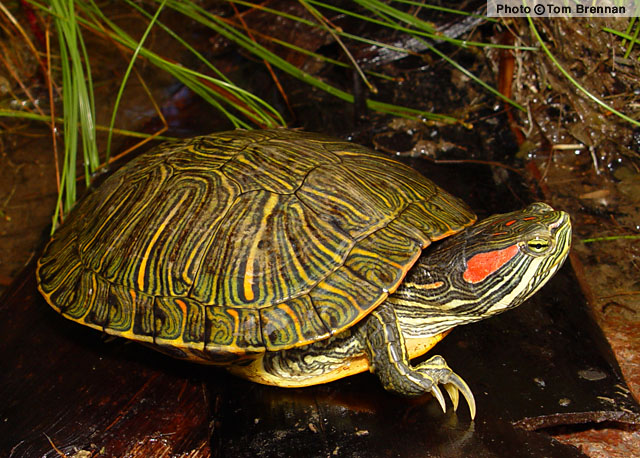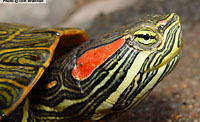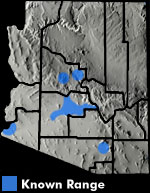Online Field Guide to The Reptiles and Amphibians of Arizona



Captive
 Captive |
| POND SLIDER Trachemys scripta | |
|
DESCRIPTION: A medium-sized (shell up to 355 mm or 14″ in length) aquatic turtle with a low, mildly keeled shell and a red patch on each side of the head. On young animals the top part of the shell (carapace) is often marked with yellow and green streaks. The carapace darkens with age and becomes uniformly black or dark brown on older adults. The head and limbs are dark olive-gray with numerous cream and yellow stripes. A dark horizontal bar runs through the middle of each eye. The bottom part of the shell (plastron) is marked with several large, dark blotches on a yellow background. The rear edge of the carapace is serrated. Females grow to a much larger size than males. The similar looking Painted Turtle does not have red patches on the sides of the head. DISTRIBUTION: This turtle’s natural range extends from the eastern and United States down into South America. In Arizona it has been introduced to rivers, canals, urban lakes, and reservoirs around Phoenix, Tucson, Yuma, and Montezuma Well. HABITAT: Generally an inhabitant of shallow, permanent water with abundant vegetation and a soft bed. Found in ponds, shallow coves within reservoirs, backwaters, and slow moving portions of rivers. REPRODUCTION: Mates in spring. Females are capable of storing sperm to fertilize a second clutch of eggs. Clutches of up to 25 eggs each are buried in moist nests on the bank in spring and summer. Eggs hatch about 10 weeks after being laid. In the cooler and less arid climate of the eastern United States hatchlings remain in the nest through the winter emerging in spring. It is not known if Arizona hatchlings overwinter in the nest or not. By Thomas C. Brennan Brennan, T. C., & A. T. Holycross. 2006. A Field Guide to Amphibians and Reptiles in Arizona. Arizona Game and Fish Department. Phoenix, AZ Brennan, T. C., & A. T. Holycross. 2005. A Field Guide to Amphibians and Reptiles of Maricopa County. Arizona Game and Fish Department. Phoenix, AZ Stebbins, R.C. 1951. Amphibians of Western North America. University of California Press, Berkeley, CA. Stebbins. 1985. Western Reptiles and Amphibians. Houghton Mifflin. New York, NY Stebbins, R.C. 2003. A Field Guide to Western Reptiles and Amphibians, Third Edition. Houghton Mifflin Company, Boston, MA. |
|
Visit Partners in Amphibian and Reptile Conservation:


HOME
Copyright © 2023, Arizona Game and Fish Department. All rights reserved.
If you make use of the textual contents of this site in reports, publications, etc. please cite and credit the author(s) and photographer(s). All photos on this website are copyrighted. However, those found in the species account section may be used for any noncommercial scientific, educational, or conservation purposes provided that photographs are not altered and continue to bear the copyright symbol and name of the photographer. Please contact the photographer regarding commercial use of copyrighted photographs.










